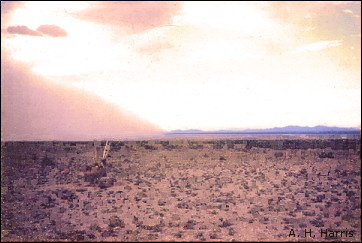

Picture a sandstorm, screaming winds blasting everything in their way with millions of tiny projectiles. Well, not to belittle sandstorms, for they can be vicious in effect on both the animate and inanimate, but most of the towering clouds are of dust, not sand. Even in high winds, sand grains are too heavy to be lifted far above the ground, and most grains move by saltation rather than long-term suspension.
If you know that "saltation" is Latin for "leaping", you may understand. A sand grain blown along the ground hits a projection (such as another sand particle) and bounces into the air, only to hit the ground and bounce again. As long as the wind is strong, untold numbers of "leaping" sand grains bounce along within inches or, rarely, a few feet of the surface.
As the sand grains clash, each impact knocks away a minute amount of
the grains' surfaces, rounding sharp angles and frosting their outsides—clues
that tell us whether ancient sands were blown by the wind or laid down by long-vanished
water.

Listen to the Audio (mp3 format) as recorded by KTEP, Public Radio for the Southwest.
Contributor: Arthur H. Harris, Laboratory for Environmental Biology, Centennial Museum, University of Texas at El Paso.
Desert Diary is a joint production of the Centennial Museum and KTEP National Public Radio, University of Texas at El Paso.

An approaching windstorm sends clouds of dust far into the air. Photograph by
A.H. Harris. <\P> ![]()